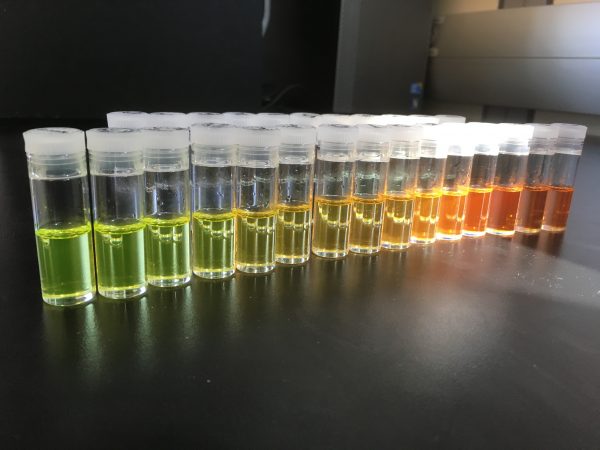Method could reduce costs for pharmaceutical, industrial and tech industries
TORONTO, April 22, 2019 – York University chemists have invented a new fluorescence-based method for accurately determining the strength of a range of Lewis acids, which could one day be used to help purify pharmaceutical drugs, improve industrial processes and explore next-generation technologies, according to a new chemistry study.
 Measuring the Lewis acidity of molecular species is important because it allows chemists around the world to establish the utility of new compounds to facilitate chemical transformations for a range of applications.
Measuring the Lewis acidity of molecular species is important because it allows chemists around the world to establish the utility of new compounds to facilitate chemical transformations for a range of applications.
The team of six York University researchers developed a new method of testing for Lewis acidity using fluorescence, which is simpler, more accurate and more effective than the commonly-used Gutmann-Beckett method.
The finding, published today in the journal Chem, could lead to improved and cheaper processes for the pharmaceutical and chemical industries.
“The pharmaceutical industry is always looking for optimized processes to make new drugs and find new chemicals,” said Thomas Baumgartner, professor in the Department of Chemistry, Faculty of Science, and Canada Research Chair in Organomain Group Materials. “Our method provides a valuable tool to help develop these processes,” said Baumgartner, who co-led the study.”
The theory of acids and bases has long been a key concept in chemical sciences. The Lewis acid-base theory, which defines acid by the ability of a molecule to accept electrons, has become increasingly important for chemistry in the 21st century, mostly in the areas of metal-free catalysis and materials science.
The team of chemists believe their Fluorescent Lewis Acid-base Adduct (FLA) method to be the first of its kind to quantify a wide variety of Lewis acids and provide the ability to visually observe differences in Lewis acid strength. They expect this technique to replace the widely used Gutmann-Beckett method, which is prone to errors.
“Until now, there has been no unifying thread to determine the strength across different species,” said Christopher Caputo, assistant professor in the Department of Chemistry, Faculty of Science, and Canada Research Chair in Metal-Free Materials for Catalysis, who co-led the study. “Some Lewis acids are charged, some are neutral, some are based on metals, some are based on non-metals and they cover the entire periodic table. With our method, we can compare across all these different species and all across the periodic table. As new chemistry and new Lewis acids are developed, our method allows you to quantify and compare all the strengths across the board, which could be very impactful.”
The research team was also composed of postdoctoral fellow Joshua Gaffen, graduate student Jordan Bentley and undergraduate research assistants, Lucas Torres and Carmen Chu. The chemists determined the strength of Lewis acids through the use of fluorescent phosphole oxides, by generating fluorescent Lewis acid-base adducts (FLAs) with distinctly altered fluorescence and colouration properties. They used fluorescent probes exposed to a Lewis acid, which changed their colour, and conducted scientific analysis using a commission internationale de l'éclairage (CIE) diagram, a tool which the illumination industry uses to define colour. They then used that definition of colour to determine the strength of a Lewis acid.
Funding for the study was provided by the Natural Sciences and Engineering Research Council of Canada, the Canada Foundation for Innovation and the Canada Research Chairs program.
York University champions new ways of thinking that drive teaching and research excellence. Our students receive the education they need to create big ideas that make an impact on the world. Meaningful and sometimes unexpected careers result from cross-disciplinary programming, innovative course design and diverse experiential learning opportunities. York students and graduates push limits, achieve goals and find solutions to the world’s most pressing social challenges, empowered by a strong community that opens minds. York U is an internationally recognized research university – our 11 faculties and 25 research centres have partnerships with 200+ leading universities worldwide. Located in Toronto, York is the third largest university in Canada, with a strong community of 53,000 students, 7,000 faculty and administrative staff, and more than 300,000 alumni.
York U's fully bilingual Glendon Campus is home to Southern Ontario's Centre of Excellence for French Language and Bilingual Postsecondary Education.
Media Contact: Vanessa Thompson, York University Media Relations, 647-654-9452, vthomps@yorku.ca

